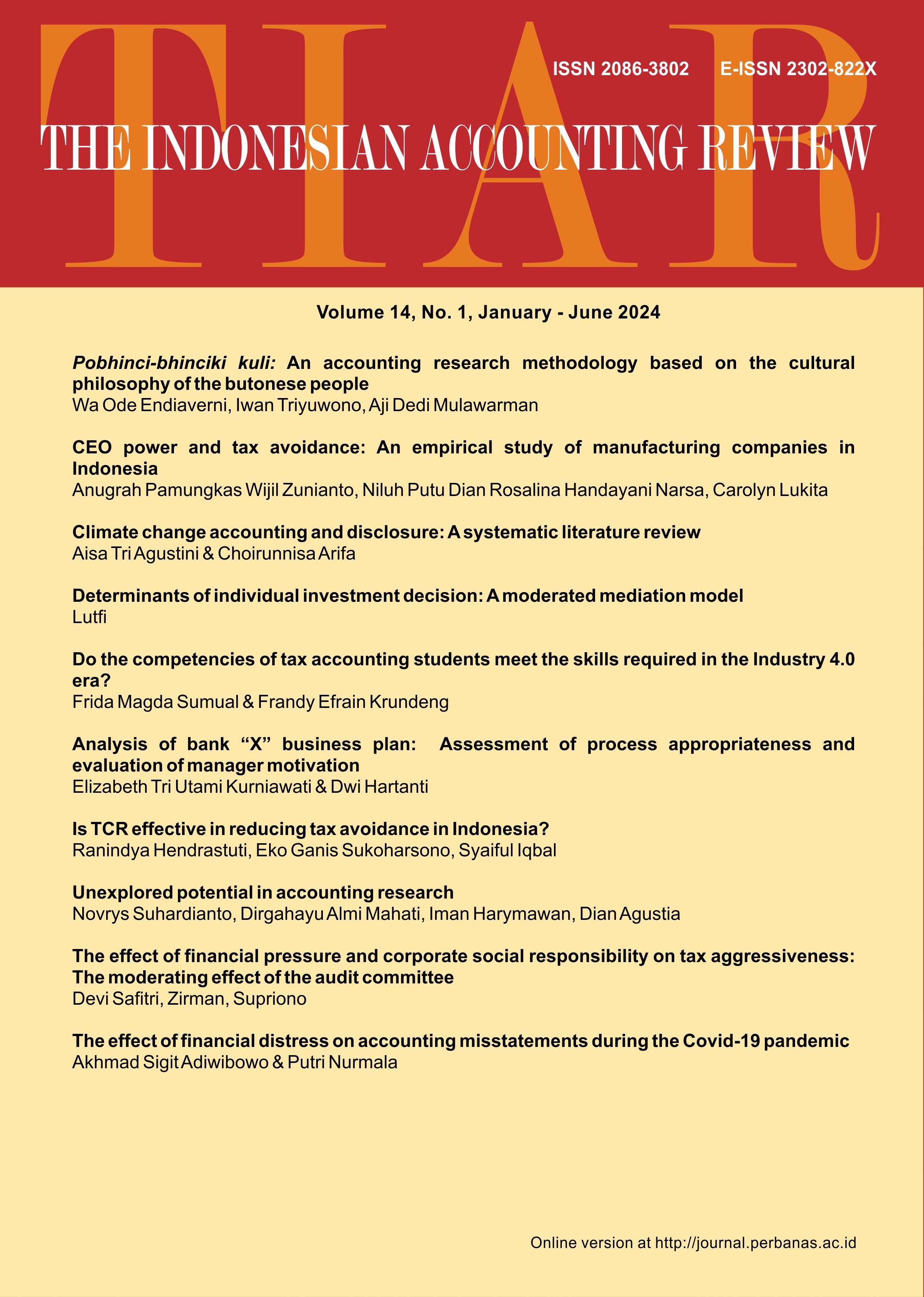Analysis of bank “X” business plan: Assessment of process appropriateness and evaluation of manager motivation
DOI:
https://doi.org/10.14414/tiar.v14i1.3845Keywords:
Bank business plan, Strategic planning, Motivation theoryAbstract
The bank business plan is a short and medium term bank strategic planning tool that must be prepared by the bank annually. The bank business plan functions not only as a company strategic planning tool for internal purposes, but also as a compliance report to relevant government agencies. With these two different functions, managers have the task of ensuring that the information in the bank business plan meets government compliance and does not reduce the company’s superiority in the banking industry. Therefore, this research aims to evaluate the accuracy and suitability of the process in preparing the bank business plan and analyze the motivation for disclosing information in the bank business plan. This research is a pioneering study that evaluates the process of preparing a bank business plan from the perspective of the bank business plan as a strategic planning tool and relates it with an analysis of motivation to disclose information using the perspective of the bank business plan as a regulatory compliance tool. This research uses a case study method with Bank “X” as the unit of analysis. The results of this research indicate that the business plan preparation process at Bank “X” has met 80% of the appropriateness criteria for the strategic plan process. Meanwhile, the motivation to disclose information in Bank “X”’s business plan tends to indicate a signal of intent. This research also reveals several things that can improve the process of preparing a bank business plan and its benefits for Bank “X”.
References
Alderfer, C. (1969). Organizational Behavior and Human Performance?: An Empirical Test of A New Theory of Human Needs. Science Direct, 4(2), 142–175.
Aquah, A., Nsiah, T. K., Akushia Antie, E. N., & Otoo, B. (2021). Literature Review on Theories of Motivation. EPRA International Journal of Economic and Business Review, 9(5), 2349–0187.
Baroto, M. B., Arvand, N., & Ahmad, F. S. (2014). Effective Strategy Implementation. Journal of Advanced Management Science, 50-54.
Basdeo, D. K., Smith, K. G., Grimm, C. M., Rindova, V. P., & Derfus, P. J. (2006). The Impact of Market Actions on Firm Reputation. Strategic Management Journal, 27(12), 1205–1219. https://doi.org/10.1002/smj.556.
Beck, T., De Jonghe, O., & Schepens, G. (2013). Bank Competition and Stability: Cross-Country Heterogeneity. Journal Financial Intermediation. https://doi.org/http://dx.doi.org/10.1016/j.jfi.2012.07.001.
Chang, C. C., & Lin, C. J. (2011). LIBSVM: A Library for Support Vector Machines. ACM Transactions on Intelligent Systems and Technology, 2, 1–27.
Connelly, B. L., Certo, S. T., Ireland, R. D., & Reutzel, C. R. (2011). Signaling theory: A review and assessment. Journal of Management, 37(1), 39–67. https://doi.org/10.1177/0149206310388419.
Corbett, G. (2018). Porphyry Copper-Gold Exploration. Short Course Manual: Unpublished.
David, F. R. (2011). Strategic Management. Erlangga.
He, Z., Qiao, G., Zhang, L., & Zhang, W. (2021). Regulator Supervisory Power and Bank Loan Contracting. SSRN Electronic Journal. https://doi.org/10.2139/ssrn.3772462
Hsu, C. C., Chiu, C. H., Lin, C. H., & Wang, T. I. (2015). Enhancing Skill in Constructing Scientific Explanations Using A Structured Argumentation Scaffold in Scientific Inquiry. Computers and Education, 91, 46–59. https://doi.org/10.1016/j.compedu.2015.09.009.
John M, B. (1988). A strategic planning process for public and non-profit organizations. Long Range Planning, 21(1), 73–81.
Kabeyi, M. J. B. (2019). Organizational Strategic Planning, Implementation, and Evaluation with Analysis of Challenges and Benefits. International Journal of Applied Research, 5, 27–32. https://doi.org/doi:10.22271/allresearch.2019.v5.i6a.5870.
Kaplan, R. S., & Norton, D. P. (2008). Mastering the management system. Special Issue on HBS Centennial. Harvard Business Review, 86(1), 62-77.
Karaman, A. S., Kilic, M., & Uyar, A. (2020). Green Logistics Performance and Sustainability Reporting Practices of The Logistics Sector: The Moderating Effect of Corporate Governance. Journal of Cleaner Production, 258, 1-10.
Kellett, P., Thompson, A. A., Strickland, J. A. J., & Gamble, J. E. (2020). Crafting and Executing Strategy: The Quest for Competitive Advantage. New York: McGraw-Hill Education.
Kollah, M. S. (2012). Strategic Planning and Efficiency of the Banking Sector: A Case of Kenya Commercial Bank Limited. Thesis. SCHOOL OF BUSINESS UNIVERSITY OF NAIROBI
Liu, F., Yu, J., Shen, Y., & He, L. (2022). Does the Resource-Dependent Motivation to Disclose Environmental Information Impact Company Financing? Evidence from Renewable Energy Companies of China. Renewable Energy, 181, 156–166. https://doi.org/10.1016/j.renene.2021.09.032.
López-Santamaría, M., Amaya, N., Grueso Hinestroza, M. P., & Cuero, Y. A. (2021). Sustainability disclosure practices as seen through the lens of the signaling theory: A study of companies listed on the Colombian Stock Exchange. Journal of Cleaner Production, 317, 1-9. https://doi.org/10.1016/j.jclepro.2021.128416
Maslow, A. H. (1954). Motivation and Personality. Harpers.
McClelland, D. C. (1955). The psychology of mental content reconsidered. Psychological Review, 62(4), 297–302. https://doi.org/10.1037/h0042263.
Mongkol, K. (2021). Strategic Management Practices in Thailand. Academy of Strategic Management Journal, 20(4), 1–11.
Munirat, A.-S. (2012). The Impact of Budgeting As a Control Mechanism in Banking Industry: A Case Study of a Nigerian Bank. IOSR Journal of Business and Management, 2(5), 45–48. https://doi.org/10.9790/487x-0254548.
Ridwan, M. S. (2015). Strategic Planning Practices An Empirical Study in the Indonesian Banking Industry. Disertation. University of Southampton.
Ridwan, M. S., & Marti, J. (2012). The Study on Strategic Planning and Organizational Performance in the Regional Government Owned Banks in Indonesia. International Journal of Humanities and Applied Sciences (IJHAS), 1(3), 98–102.
Šehić-Kršlak, S. & Kršlak, Adnan. (2017). Planning as a Management Function in Modern Banking Systems. nternational Scientific Journal Science. Business. Society, 26(1), 24–26.
Seelye, N., Ziegler, P. W., & Routh, T. B. (2021). The Stability of the U.S. Commercial Banks During the COVID-19 Pandemic: Impacts and Implications from Regulator and Management Decisions. Accountancy Business and the Public Interest, 6.
Steiner, J. E. (1979). Human Facial Expressions in Response to Taste and Smell Stimulation. Advances in Child Development and Behavior, 13(C), 257–295. https://doi.org/10.1016/S0065-2407(08)60349-3.
Yıldırım-Karaman, S. (2017). Uncertainty Shocks, Central Bank Characteristics and Business Cycles. Economic Systems, 41(3), 379–388. https://doi.org/10.1016/j.ecosys.2016.09.004.
Yuneline, M. H., & Anggono, A. H. (2012). Alternatif Strategi Keuangan Pada Rencana Bisnis Bank BJB Untuk Memperkuat Permodalan. Jurnal Manajemen Teknologi, 11(3), 326–337.
Downloads
Submitted
Published
How to Cite
Issue
Section
License
Copyright (c) 2024 The Indonesian Accounting Review

This work is licensed under a Creative Commons Attribution-NonCommercial 4.0 International License.


















